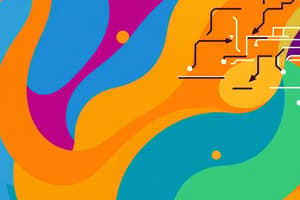Podcast
Questions and Answers
What stage in the software engineering process develops an executable software system?
What stage in the software engineering process develops an executable software system?
- Testing
- Requirement Gathering
- Deployment
- Design and Implementation (correct)
Software design is primarily a mechanical activity focused solely on coding.
Software design is primarily a mechanical activity focused solely on coding.
False (B)
What is a fundamental principle of open-source development?
What is a fundamental principle of open-source development?
- Source code should be freely available (correct)
- Open source software is always free of charge
- Source code should be kept confidential
- Developers cannot place restrictions on code usage
What does COTS stand for in the context of software systems?
What does COTS stand for in the context of software systems?
Anyone can do whatever they wish with open source code without any restrictions.
Anyone can do whatever they wish with open source code without any restrictions.
In the object-oriented design process, the first step involves defining the ______ and modes of use of the system.
In the object-oriented design process, the first step involves defining the ______ and modes of use of the system.
Match the following processes with their common activities:
Match the following processes with their common activities:
What should be considered during the software development process regarding existing software?
What should be considered during the software development process regarding existing software?
Which of the following benefits does buying off-the-shelf systems provide?
Which of the following benefits does buying off-the-shelf systems provide?
In open source licensing, the developer retains ownership of the code and can impose __________ on its use.
In open source licensing, the developer retains ownership of the code and can impose __________ on its use.
Match the following aspects of software design and implementation with their descriptions:
Match the following aspects of software design and implementation with their descriptions:
The design process for small systems requires extensive development of models.
The design process for small systems requires extensive development of models.
What is the purpose of specifying object interfaces in the object-oriented design process?
What is the purpose of specifying object interfaces in the object-oriented design process?
Which of the following is NOT an element of pattern descriptions?
Which of the following is NOT an element of pattern descriptions?
Open source development encourages proprietary software practices.
Open source development encourages proprietary software practices.
What is the most well-known open source product?
What is the most well-known open source product?
In open source development, the source code of a software system is __________.
In open source development, the source code of a software system is __________.
Match the open source products with their primary functionalities:
Match the open source products with their primary functionalities:
What is a crucial aspect of configuration management in software development?
What is a crucial aspect of configuration management in software development?
Production software typically runs on the same computer as the development environment.
Production software typically runs on the same computer as the development environment.
What is the primary focus of implementation issues in software development?
What is the primary focus of implementation issues in software development?
What is the purpose of a system context model?
What is the purpose of a system context model?
An interaction model is a static model that describes how the system interacts with its environment.
An interaction model is a static model that describes how the system interacts with its environment.
What is the iterative process in object identification?
What is the iterative process in object identification?
A design pattern is a way of reusing abstract knowledge about a problem and its ______.
A design pattern is a way of reusing abstract knowledge about a problem and its ______.
Match the following design model types with their descriptions:
Match the following design model types with their descriptions:
Which architectural pattern may be used in system component organization?
Which architectural pattern may be used in system component organization?
Design models only describe the static structure of a system.
Design models only describe the static structure of a system.
What is an example of a dynamic design model?
What is an example of a dynamic design model?
Flashcards
Software design and implementation
Software design and implementation
The stage in software development where an executable system is built. Involves both designing software components and their relationships, and implementing the design as code.
Off-the-shelf systems (COTS)
Off-the-shelf systems (COTS)
Ready-made systems that can be adapted to meet user needs. Can be cheaper and faster than custom development.
Structured object-oriented design processes
Structured object-oriented design processes
Object-oriented design processes use multiple system models to structure the design. These models can help with large projects, but may be too complex for smaller ones.
Context and modes of use
Context and modes of use
Signup and view all the flashcards
System architecture
System architecture
Signup and view all the flashcards
Principal system objects
Principal system objects
Signup and view all the flashcards
Developing design models
Developing design models
Signup and view all the flashcards
Specify object interfaces
Specify object interfaces
Signup and view all the flashcards
System Context Model
System Context Model
Signup and view all the flashcards
Interaction Model
Interaction Model
Signup and view all the flashcards
Architectural Design
Architectural Design
Signup and view all the flashcards
Object Class Identification
Object Class Identification
Signup and view all the flashcards
Design Models
Design Models
Signup and view all the flashcards
Design Pattern
Design Pattern
Signup and view all the flashcards
Sequence Model
Sequence Model
Signup and view all the flashcards
State Machine Model
State Machine Model
Signup and view all the flashcards
Open source licensing
Open source licensing
Signup and view all the flashcards
Open source development
Open source development
Signup and view all the flashcards
Software reuse
Software reuse
Signup and view all the flashcards
Object models
Object models
Signup and view all the flashcards
Linux
Linux
Signup and view all the flashcards
Configuration Management
Configuration Management
Signup and view all the flashcards
Host-Target Development
Host-Target Development
Signup and view all the flashcards
Polymorphism
Polymorphism
Signup and view all the flashcards
Inheritance
Inheritance
Signup and view all the flashcards
Study Notes
Chapter 7 - Design and Implementation
- Software design and implementation is the stage in the software engineering process where an executable software system is developed.
- Software design and implementation activities are invariably inter-leaved.
- Software design is creative, identifying software components and their relationships, based on customer requirements.
- Implementation is realizing the design as a program.
- COTS (off-the-shelf systems) can be adapted to user needs
- Implementing a medical records system as an example, using COTS systems can be faster and cheaper compared to development in a conventional programming language.
- Design using COTS needs understanding of configuration features.
- Structured object-oriented design uses many system models, requiring significant development and maintenance effort, and may not be cost-effective for small systems.
- Large systems developed by different groups rely on design models as communication mechanisms.
- Common activities in object-oriented design processes include defining the system's context, defining modes of use, designing the system architecture, identifying principal objects, creating design models, and specifying interfaces.
- System context models are structural, showing the other systems in the environment.
- Interaction models are dynamic, demonstrating how the system interacts with its environment.
- Architectural design involves identifying major components and interactions.
- Architectural patterns, like layered or client-server, can organize components.
- Object class identification is often difficult
- There's no 'magic formula', relying on the skill, experience, and domain knowledge of system designers.
- Object identification is an iterative process.
- Design models show objects, classes, and relationships.
- Structural models describe the static structure of the system in terms of classes and relationships.
- Dynamic models describe the interactions between objects.
- Examples of design models include subsystem models (logical groupings), sequence models (sequences of interactions), and state machine models (how individual objects react to events).
- Design patterns reuse abstract knowledge of problem and solution.
- A design pattern is a description of the problem and the essence of its solution.
- Patterns should be sufficiently abstract to be reusable.
- Descriptions use object-oriented characteristics like inheritance and polymorphism.
- Pattern elements include a name, problem description, solution description, and consequences (results and trade-offs of use).
- Implementation issues focus on aspects outside programming, including reuse of existing components, configuration management (tracking versions), and host-target development (development on one system, execution on another).
- Open source development publishes source code, allowing volunteers to participate.
- Open source code is rooted in the Free Software Foundation (www.fsf.org), advocating that source code should be accessible and modifiable.
- Linux is a well-known example of an open-source operating system.
- Other important open-source products include Java, the Apache web server, and the MySQL database management system.
- Some product companies use open-source development for cost-effectiveness, speed, and community building.
- A fundamental principle of open-source development is providing freely available source code, though with potential legal restrictions (open source licenses).
- Developers may require systems built from components to also be open source, and others may allow usage without restrictions.
- Software design and implementation are inter-leaved activities.
- Object-oriented design details system architecture.
- Design uses models to identify objects and describe interactions.
- Consider reuse, employing existing software assets.
- Open source development makes source code publicly available.
Studying That Suits You
Use AI to generate personalized quizzes and flashcards to suit your learning preferences.




